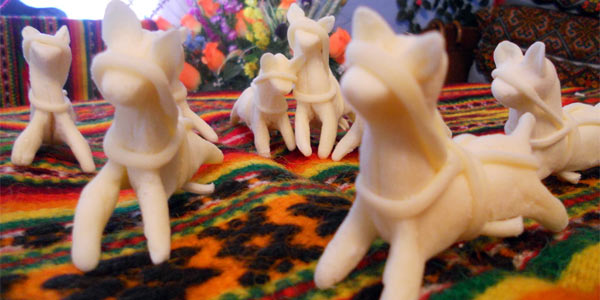 19.04.2018
Hutsul cheese toys
19.04.2018
Hutsul cheese toysMany creative people and craft masters keep under wraps their own technological and artistic acquirement until the last breath. Maria Matiichuk, a member of the National Union of Artists of Ukraine belongs to Hutsuls with sincere soul. She gladly shares secrets of her craft, and recently complains: “And who will do it tomorrow? Who will model as I do it? “..
Ms. Maria is engaged in manufacturing toys of cheese for more than half a century. Some years of her work she gave to children.
For a few minutes funny fantastic creatures are born in her hands from a piece of cheese. Her main “trick” is accessories: original neck adornments, extremely unique harness consisting of a saddle, gear, bridles in addition of small barrels which imitate barrels with seep’s cheese. All this composition is crowned with a rider – Hutsul in keptar and hat which supposedly carries dairy products from the mountain valley.
A special product is required by making a toy of usual cheese. Such artistic articles can not be made of any kind of cheese. First of all, cheese horses are an edible product. So an end product depends on raw material and its preparing. That’s why raw materials are assiduously selected. Cheese is prepared of cow milk (previously sheep cheese served as toy product). And the more delicious milk is, the better “rams” taste. Milk should be fresh, and from a good cow, as Hutsuls said. It is also forbidden to use milk from a cow which has just calved.
But the right choosing of milk is not enough for the product to be success. Milk is warmed up a little, then “hleh” is thrown into milk (powder that makes milk sour) and this mixture is put in a warm place.
What is “hleh” and what is it made of?
Nowadays oxidants made chemically are used in dairy technology. And folk method of this product’s preparation is definitely more interesting.
First Hutsuls take “rynza” – a bag made from stomach of a young calf which has fed only with mother’s milk and has not eaten herbal food. Then they pour into the bag milk after first milking (from cows that has just calved), tie the bag and let this mixture settle about three – four weeks, during this time milk ferments and “thickens” by virtue of stomach enzymes.
But let’s return to preparing cheese. “Curdle” milk settles about a day, and then roped mixture is poured into cheesecloth, tied and let for flowing whey, after that only cheese remains in cheesecloth.
Actually, at this stage of preparing whey it is important for milk not to be left too long and for cheese not to be too sour, because “rams” of such product are “already worthless”. They quickly sour, crumb and mould.
And if this technology is followed, the products can be remained for several decades.
Also “rams” or “horses” are made of this cheese. A vessel with water and salt (in proportion 2:1) is placed close by, and a vessel with boiling water stands on a hot plate.
Cheese is cut into pieces various in size, whatever a master intends. One piece is thrown into boiling water, taken out with the wooden spoon and crumbled like dough. Cheese should remind plasticine – be plastic and pliable.
Legs, neck and head of a horse are made by pulling cheese mass in one or other side. Several skilled finger movements – and we see a horse awaiting a final stage.
And the most effective procedure of this work consists in putting the horse in harness. With long thin threads of cheese master braids delicate plaits of different thickness, skillfully binds a figure of horse making various beautiful nodules.
In order to make a work festal details are painted on with light dots, narrow strips of green and crimson colors using food dyes.
-
 27.02.2024
World of pysanka
Embark on a journey into the captivating world of Pysanka, the Ukrainian...
27.02.2024
World of pysanka
Embark on a journey into the captivating world of Pysanka, the Ukrainian...
-
 29.01.2024
Exploring the Treasures of Kyiv’s Lavra Monastery
In the heart of Kyiv lies the venerable Lavra Monastery, a testament...
29.01.2024
Exploring the Treasures of Kyiv’s Lavra Monastery
In the heart of Kyiv lies the venerable Lavra Monastery, a testament...
-
 13.01.2024
Kachanivka, Eden on Earth
Rich in history, it hosted renowned artists, notably poet Taras Shevchenko.
13.01.2024
Kachanivka, Eden on Earth
Rich in history, it hosted renowned artists, notably poet Taras Shevchenko.

